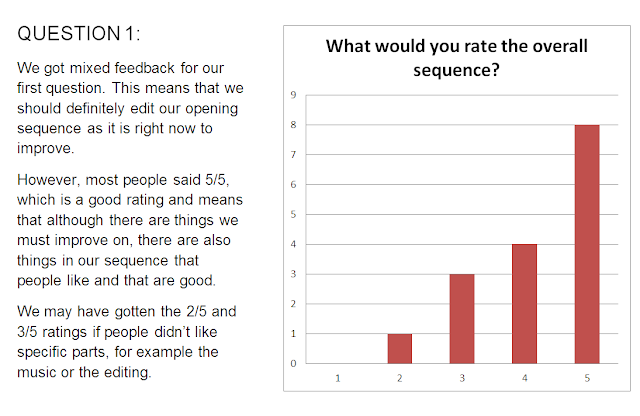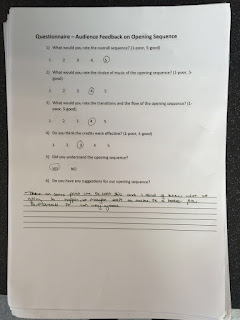Monday, 25 April 2016
Saturday, 23 April 2016
Thursday, 21 April 2016
EVALUATION - Question 5
We have completed an interview with one of the members of our year group, who fitted some of the boxes of our target audience member, but who is not our 'ideal' audience member.
MONIQUE:
MONIQUE:
- AGE - 17
- GENDER - Female
- CLASS - Middle
- ETHNICITY - Mixed Race
- LIKES/HOBBIES - Cooking & swimming
- FAVOURITE GENRE OF FILM - Horror/thriller
Tuesday, 19 April 2016
Monday, 18 April 2016
Sunday, 17 April 2016
Friday, 15 April 2016
Wednesday, 13 April 2016
Final Main Production Task
Here is our final opening sequence. We have taken into account our feedback from our questionnaires and have edited accordingly. We have made the editing smoother so that there are no lags and so that the pace is fasted to suit the tension of the sequence. we have also added the most voted for font for our 'Schizo' title to make it more appealing. To make the music more effective, we have stopped it at certain times and on top of this, added a drawing sound effect over the title so make it resemble someone drawing it out. I am very proud of what we have accomplished with this piece and I believe that we have produced it to the best of our ability.
Additionally, we realised that we made a spelling mistake for 'director of photography' in our other drafts for our opening sequence, and we have corrected it in our final piece.
As well as this, we have decided to create an ending that creates more anxiety, so we have cut out the last 10 seconds where Lauren says "you?". This has made the sequence shorter and has made the audience more on edge because of the abrupt ending.
Tuesday, 12 April 2016
Second Draft - Opening Sequence
Here is the opening sequence that we showed our class and took feedback from them on how to improve it and create our final cut.
The main topic that came up was the ending of the scene in which the character says "you?". Some students said that they thought the editing of the ending was quite slow and it would be more dramatic if it was cut shorter.
We also got feedback to not use fake names, as we used here, and instead create the credits using our real names, so the opening is more personal. This would hopefully make the credits more effective in the opening sequence.
Here is our second draft for our opening sequence.
Sunday, 10 April 2016
Friday, 8 April 2016
Bibliography for Research and Planning
Name of Source
|
Hyperlink
|
What
information was used
|
What post I used it on
|
(WEBSITE)
Wikipedia
|
https://en.wikipedia.org/wiki/Opening_credits
|
Common opening credits order
|
Extensive research on jobs appearing in credits
|
(WEBSITE)
Wikipedia
|
https://en.wikipedia.org/wiki/Opening_credits
|
History of opening credits
|
Opening credits research
|
(WEBSITE)
New England Film
|
http://newenglandfilm.com/magazine/2012/08/credits
|
How and why opening credits are used
|
Opening credits research
|
(WEBSITE)
Wikipedia
|
https://en.wikipedia.org/wiki/Thriller_(genre)
|
Themes and characters
|
Codes and conventions of the thriller genre in
film.
|
(PDF) Correspondence
analysis of genre
preferences in UK film
audiences
|
http://www.participations.org/Volume%209/Issue%202/4%20Redfern.pdf
|
Cross-tabulation of interactively-coded
gender-age variable with genre
|
Relationship Between Age, Gender, and Genre:
SECONDARY RESEARCH
|
(WEBSITE)
Wikipedia
|
https://en.wikipedia.org/wiki/Alfred_Hitchcock
|
Main page information
|
Alfred Hitchcock - Suspense and Thriller
|
(WEBSITE)
Wikipedia
|
http://www.bbfc.co.uk/
|
12A/12 and 15 information
|
The BBFC Certificate of Our Film
|
(WEBSITE)
Twyman-Whitney
|
http://www.twyman-whitney.com/film/essentials/music-history.html
|
History of film scores
|
The History/Elements of Film Scores
|
(WEBSITE)
Wikipedia
|
https://en.wikipedia.org/wiki/Film_score
|
Elements of a film score
|
The History/Elements of Film Scores
|
(WEBSITE)
Scaruffi
|
http://www.scaruffi.com/history/film.html
|
First rock song appearing in film
|
The History/Elements of Film Scores
|
Friday, 25 March 2016
The Filled Out Questionnaires - Audience Feedback on Opening Sequence
Thursday, 24 March 2016
The Filled Out Questionnaires - Font of Film Name
We were undecided on a few fonts for the title of our opening sequence. We asked 16 media students of different genders and ethnicity's, who were all the ages of 16-18 to fill out a questionnaire to help us decide which font suited our opening sequence the most.
Disclaimer - we accidentally added a ninth option to tick, however it is discarded because we did not add one to choose.
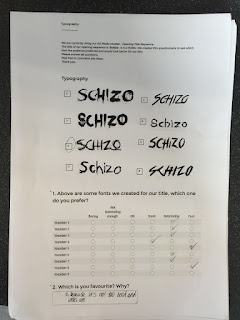


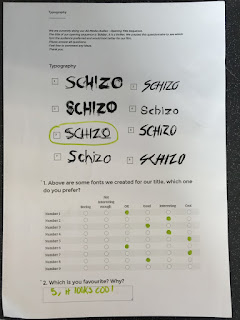
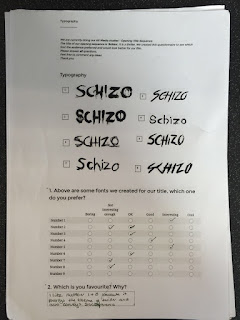
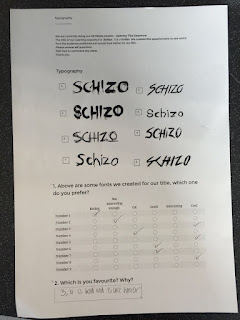

Disclaimer - we accidentally added a ninth option to tick, however it is discarded because we did not add one to choose.
Here are the filled out questionnaires:







Mapping of Our Opening Sequence
In the first cut of the sequence, we used fake names, but we ended up changing the names to our actual names. All together there are 14 titles, which is not a heavy amount like a Hollywood film would be, but it is enough to be effective.
Monday, 14 March 2016
Final Animated Production Company Logos
Here are our final animated production company logos that we have created using Serif DrawPlus X6. Some of them are a bit blurry and not very clear, however we still think they are still usable and we will ad some sound effects to them when we add them to our final piece so that they are more effective.
Friday, 11 March 2016
Logo For Production Company
We have taken our initial sketches of our production company logo and have turned them into our final production company logo using the program 'Serif Draw Plus X6'.
These are our options for our production company logo, however we have changed them from sketches into suitable logos so that we could accurately decide which one we like out of them all.
After seeing how the designs looked, we decided upon this design, as it is simple, yet effective. We have then animated the logo so that we can include it into the beginning of our opening sequence.
Sunday, 6 March 2016
Lighting, Editing and Sound - Research
Lighting:
- HIGH KEY - The lighting is bright and may include mixed white colours. We won't be using this lighting because we can't to create a somewhat unsettling atmosphere for the audience.
- LOW KEY - This lighting is dark and may include shadows and dark tones. We might be using this lighting because it will create a dark vibe, but we don't want our sequence to come off as a horror so we might opt for something else.
- COLOUR FX - Different colour combinations depending on the atmosphere of the film. Examples are black and white or sepia, as well as blueish effects or warm yellow effects. We might use this lighting as opposed to the low key lighting. This is because we can make the sequence dark and creepy but not too scary so it can be seen as a thriller and cause suspense.
In this video I have used an effect from iMovie called 'Day to Night', which includes bluish but dark tones and makes the lighting low key.
EDITING:
- CONTINUITY EDITING - Film sequences normally follow this type of editing in order to make them flow and transition in a believable way. Only cuts will be used in order to make scenes more realistic.'Cross-cutting' may also be included, which is when two different pieces of action are shown at the same time during a sequence, but it still maintains a flow to make it have a 'real life' affect. This is the main common editing style in film, so we will be using it in our opening sequence, however we may add some fades in and out of the sequence to create more variation.
- MONTAGE EDITING - The opposite of continuity editing, whereby the cuts in the sequence are noticeable and don't have a flow of time.
- CUT - An image is instantly replaced by another without a noticeable transition. We will be using this because it is used in continuity editing.
- CROSS/DISSOLVE - One image dissolves into another.
- FADE UP - An image fades in from black. We will be using this to transition from the quote to the start of the scene.
- FADE OUT - An image fading out to black. We may use this after the title of the film is shown.
- WIPE - One image replaces another and the border between the image will move across the screen.
SOUND:
- DIEGETIC SOUND - Sound that is involved and is part of the film world e.g. cars or birds. We will be using this for our phone sound effects.
- NON-DIEGETIC SOUND - Sound that is not part of the film world and is not part of what is happening on screen e.g. a soundtrack. We will be using a soundtrack in our opening sequence.
- SOUND BRIDGE - Linking two scenes together through sound. We may use this in our task.
- SOUND EFFECTS - Sound which is added on which is not dialogue or music. Sound is added during post-production e.g. our phone ringing sound effects.
Friday, 4 March 2016
Logo for Production Companies Planning
Here are drawings of our initial ideas for what we would like our production logos to look like. We will choose three of these for our final production and animate them to make them more attractive.
Analysis of Non-diegetic Soundtrack Music
This is the non-diegetic, asynchronous soundtrack that we chose to use for our final opening sequence. I have gone through the section of the soundtrack that we will be using and I have gone through it describing why we are using it any why it suits our opening sequence perfectly. Whilst editing the opening sequence when it is completed, I will add sound effects to it, such as sounds for the production logos, the phone ringing, and various other sound effects.
Here is my analysis of the piece:
Here is my analysis of the piece:
Here is the piece of music by itself:
Sunday, 28 February 2016
Our Non-diegetic Asynchronous Soundtrack Options
No Games - Civil Ryan
The first option for our soundtrack is a song produced my one of my friend's Ryan. It is quite fast-paced, so we may use this if our opening sequence ends up being a horror (idea one) because it sounds more upbeat than a soundtrack for a thriller film. This track isn't very creepy, but may suit a running scene or a scene with a lot of action.
Haunted - Ross Bugden
This second option is one of our favourites because it would go well with a thriller (idea two) and sounds very creepy. This is the sound that we're going for at the moment and resembles a child-like soundtrack or a lullaby. This soundtrack is copyright and royalty free, so I wouldn't have to pay to use it.
Witch's Lair - Desperate Measures
This last option creates a more eerie atmosphere than the first two and would also go well with a thriller opening sequence. It may suit a stalker scene or someone being followed and is also copyright and royalty free so would be easy to use.
Friday, 26 February 2016
Psycho Film Scored Analysis
This is one of the most popular pieces of film score music. It was composed by Bernard Herrmann and is the theme for the film Psycho, by Alfred Hitchcock. It could be argues that the Psycho theme is Herrmann's best and most admired film score. It was created on a low budget and so only involves string instruments, which happen to suit the genre of a horror/thriller. Herrmann had the idea that the string instruments to reflect the black and white cinematography. The theme is played in the very beginning of the film with the opening credits, as well as appearing in other intense parts of the film (the infamous shower scene). The fact that the score is just string instruments and it is a somewhat small instrumental ensemble creates tension for the audience because of the fact that it is quite fast paced and the volume of the instruments often change with sharp jabs of violin to shock the audience.
The score has influenced many other pieces, including one adaptation of the score by Danny Elfman, which was actually made for the 1998 remake of the film. Elfman is a famous composer and song-writer and has worked with people such as Tim Burton. There are other scores that have been influenced by Psycho, which have copied it's use of sharp jab sounds to create suspense.
The theme plays in the opening credits, however nothing dramatic actually happens for the first 15-20 minutes of the film, which created the affect of the audience being on edge because the theme would be stuck in their heads whilst they are watching the first few scenes.
I will be finding a score for out opening sequence, which created tension for our audience. Psycho is a horror/thriller, however out film won't include many elements of a horror. Therefore, the piece that we end up using may be a bit slower paced than this score. We want it to have a dark tone and be a bit unsettling so that the audience know that there is something wrong and they can be on edge whilst watching.
Thursday, 25 February 2016
The History/Elements of Film Scores
The History of Music in Film
Before the 1930s all movies were silent. Music was commonly included in theatre productions and was brought to films to add some depth to the images shown on the screen for the audience as well as for tradition.
The majority of silent films were accompanies by full orchestras, organists, and pianists. Various books of music were published to provide ideas for scene music to have an affect on mood, element, or event.
During the 1930s, music was established as a vital element within film. Sound within films was usually Western Classical Music (from the 19th century) would play over the film. However, original scores started to become a normal thing.Mas Steiner was the first to write a completely original score for King Kong (1933). Composers began to develop their own styles of supporting film.
In the 1940s, composers began to evolve in their work, and one of the most important and influential composers was Bernard Hermann (who I have mentioned on a previous post). He was able to create music to enhance the films that they were made for.
Jazz music had become common in the industry from the 1950s. It required less musicians, so orchestration was less expensive. James Myers and Max Freedman wrote the first rock song to appear in a film (1953), as the use of different genres was experimented with. The 1960s and 1970s included perfecting previously learned techniques and uses and also a few highly memorable scores.
The first widespread use of synthesized sound took place in the 1980s, which stemmed a film score revolution which made it a more popular choice. it became possible to score a whole film with only one performer for the very first time, using a synthesizer to product the sounds of various instruments. This caused popular songs to be produced and used as film scores.
Today, with the ongoing development of new technology and knowledge, film composers have the ability to create the perfect film score. This enhances the film and transforms it into an experience for the audience.
The majority of silent films were accompanies by full orchestras, organists, and pianists. Various books of music were published to provide ideas for scene music to have an affect on mood, element, or event.
During the 1930s, music was established as a vital element within film. Sound within films was usually Western Classical Music (from the 19th century) would play over the film. However, original scores started to become a normal thing.Mas Steiner was the first to write a completely original score for King Kong (1933). Composers began to develop their own styles of supporting film.
In the 1940s, composers began to evolve in their work, and one of the most important and influential composers was Bernard Hermann (who I have mentioned on a previous post). He was able to create music to enhance the films that they were made for.
Jazz music had become common in the industry from the 1950s. It required less musicians, so orchestration was less expensive. James Myers and Max Freedman wrote the first rock song to appear in a film (1953), as the use of different genres was experimented with. The 1960s and 1970s included perfecting previously learned techniques and uses and also a few highly memorable scores.
The first widespread use of synthesized sound took place in the 1980s, which stemmed a film score revolution which made it a more popular choice. it became possible to score a whole film with only one performer for the very first time, using a synthesizer to product the sounds of various instruments. This caused popular songs to be produced and used as film scores.
Today, with the ongoing development of new technology and knowledge, film composers have the ability to create the perfect film score. This enhances the film and transforms it into an experience for the audience.
Elements of a Film Score
TEMP TRACKS
This is an existing piece of music score, which is used during editing to guide the mood or atmosphere. Composers are often asked to recreate or imitate a specific composer or style in the temp track. Sometimes directors like the temp score more than the original score and choose to reject it.
STRUCTURE
Films often include different themes for character, events, ideas or objects. these can be played in different styles or variations depending on what they represent. For example, John Williams' score for the Star Wars Saga includes different themes that are associated with different characters: Darth Vader, Luke Skywalker, and Princess Leia.
SOURCE MUSIC
Most films have around 40 to 120 minutes of music. Some have very little, and some have music that plays throughout. Source music is music that only comes from an on screen source that can actually be seen, for example music playing from a TV or a radio.
SOURCE MUSIC
Most films have around 40 to 120 minutes of music. Some have very little, and some have music that plays throughout. Source music is music that only comes from an on screen source that can actually be seen, for example music playing from a TV or a radio.
Wednesday, 24 February 2016
Film Name - Target Audience Feedback
Whilst brainstorming ideas for our opening sequence and thinking about what we wanted the plot to be. We had to think about what we wanted the name of our film to be. Although we have already produced the first cut of the opening sequence, we weren't certain on the initial name that we chose. We used 'Skitzo' but then decided that we liked 'Schizo' as well. This is because we wanted to portray the idea of the protagonist having schizophrenia so both would work. However, we couldn't decide on which one we wanted to use for our final cut. We decided to write them both on A4 pieces of paper and ask 10 students from a year 13 media class (aged 17-18) to write their name on a post-it note and stick it on their favourite title.
We picked this class because we wanted to ask students who would be able to watch the film in the cinema, as out BBFC rating is a 15. We also asked both boys and girls to get a varied opinion.
As you can see, 6/10 students liked 'Schizo' as the title, therefore we will be changing our film title because we personally like 'Schizo' more, and other people do as well.
Subscribe to:
Comments (Atom)

